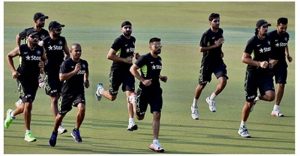
A lot of fitness trainers work as freelancers in the industry. Then there are some who begin their career by working for a gym or a fitness club, but eventually, become independent and start their own business. Here are useful tips & suggestions on how to carve a successful career as a fitness/personal trainer.
What Does a Fitness Trainer Do?
Fitness trainers help set up fitness goals for the client (in consultation with the client) and help them achieve those goals.
In the gym, trainers are known as Gym trainers or floor trainers (as they are all required to stand on the gym floor and observe people while exercising).
The trainer takes physical information of the client such as: Age, Weight, Height and size of Chest, Arms, Thighs, Forearms, Calves; some trainers even capture pictures (taken from the front, back and sides) for later comparison.
The fitness trainer creates an exercise plan for the client, which includes Warm exercises, Names of the exercises, Number of repetitions, Rest time between exercises, Number of sets, Stretching exercises & How to cool down, What exercises to do on which days.
Basically, a fitness trainer is expected to train clients to achieve their fitness goals, but depending on the years of experience, a gym instructor may have to take on additional responsibilities.
Job Description of Gym / Fitness Trainer: Fitness trainers and instructors typically do the following:
- Do fitness assessments for new clients, take their body measurements and check their existing fitness levels
- Prepare exercise plan for clients based on their fitness goals and body type
- Explain how to use the various exercise equipment
- Demonstrate how to carry out the various exercises with the right form
- Watch clients exercising on the floor and stop them from doing incorrect techniques to minimize injury
- Give a helping hand (support) to clients who take heavy weights for exercising
- Monitor clients’ progress and modify exercise routines as needed
- Give clients information on nutrition, weight control, and lifestyle issues
- Give emergency first aid if needed
- Take part in marketing and promotional activities of the gym
A gym trainer must also have good communication skills since they work with different types of people (gender, ages).
A gym instructor must also be courteous (after all, they work in the service industry) and show great principles for providing customer and personal services.
Related: Trends in the personal fitness training industry.
Growing Demand for Qualified Trainers
In the past, there was a lot of ignorance in the fitness industry in India and training was often based on some age-old beliefs (most of which are usually myths) because of which patrons would do incorrect forms and not get the desired results.
However, things are different today!
The fitness industry is booming thanks to a growing interest in health & fitness among people. As a result, the demand for good and knowledgeable fitness trainers has also increased.
Qualified fitness trainers are needed at health and fitness clubs, gyms, spas, and also as freelancers.

Important to be Certified
In order to become a fitness trainer, you must first get a certification in fitness training. Once you complete your training and become a certified trainer, you can start working as a trainer.
The first step for any fitness trainer should be to get certification from a reputed fitness training institution.
You need formal education to qualify as a fitness coach. Its important to be a qualified personal trainer and have other related qualifications like being a sports massage therapist, nutritionist and so on. These qualifications will certainly help you to get more business and find acceptance from most fitness enthusiasts.
There are several fitness academies in India that offer training and certifications to fitness trainers.
Related: why trainers must be scientifically trained.
There are several institutes that offer certifications and diplomas on personal training. Here are the top fitness certifications & courses in India (personal fitness trainer/gym trainer).
Beginning your career as a fitness trainer
While there is good demand for knowledgeable trainers, it takes time to establish oneself in this business as there is a lot of competition as well.
A lot of wannabe fitness trainers first get certified and then start by working for a gym. Over time, they prove themselves and build relationships with clients, and many then set out to become freelancers or setup their own personal training business.
Once you are ready to start your own business, promote yourself well. Get a business card printed to sell your services. Always strive to offer high-value services to your clients while maintaining a high level of communication with them.
Personal trainers work with individual clients (and even small groups) and offer personalized exercises and nutrition plans.
While there’s nothing wrong with working for a gym, fitness trainers should consider starting a personal training business as it will give them more control over their time, career, and they will also be able to make more money than working for a gym or fitness club. Trainers today can even offer their services online.
How much can you earn?
Beginners can earn around 30-50K per month; experienced coaches can earn a lot more. Once you have trained and transformed sufficient number of people, have several positive client testimonials, solid online presence, then you can easily earn in lakhs.
The well-known ones, those who train celebrities, prefer opening their own training centers.
Related: Here’s how much the top celebrity personal fitness trainers charge.
However, you need to remember that this career requires total dedication toward transforming your client.
Online Fitness Training Gains Momentum
Online personal training is huge in foreign countries where fitness trainers and coaches train clients far and wide. The trend is growing fast in India as well, and you can now get your personal fitness trainer to train you online.
India is going ‘online’ big time, with users not just buying things online but also opting for services online, and not that also includes the services of personal fitness trainers.
Personal trainers provide personalized exercises (and even nutrition plan) as per your needs. The concept of hiring an online personal trainer is more or less similar to hiring a personal trainer in some local gym.
- Pros: Affordability & flexibility, saves you commuting time.
- Cons: No one to supervise technique and/or prevent injury.
If you’re a beginner who enjoys face-to-face interaction and/or a structured fitness regimen, in-person training is probably best for you. But if you just need a little nudge or some extra expertise, an online trainer is a great way to make your investment last a lot longer.
Nutritionist and Bollywood celebrity trainer Rujuta Diwekar, says, “It is not always possible to meet clients and train them in person due to their hectic schedules. This is when I train my clients online, and this includes people from different parts of the world.”
You can call your trainer on his/her phone to clarify your doubts, and probably have a personal meeting once or twice a month (if you happen to be in the same city).
You can even do the exercises in your local gym but not opt for a personal trainer at the gym (they tend to be more expensive).
How to Grow Your Personal Training Business
You need to find clients whom you can physically train (face-to-face) at your home/local gym/studio, you need to find clients whom you can sell nutrition products, supplements and related products. Lot of online personal trainers are able to coach multiple people (at varied locations) at the same using the platforms like Skype, WhatsApp and even Emails.

As a trainer, you should leverage the power of social media. You need to exhibit your knowledge on social media platforms like Instagram and Facebook in order to build a community online and to develop trust. Once your popularity soars, you can make a lot of money just by posting interesting fitness related things online.
In order to get started with your online personal training business, you need to Plan, Prepare, Proceed and Pursue.
PLAN: One of my favor quotes is, “Failure to plan is planning to fail.” If you are serious and ready to explore how to expand into the online side of your business (and by the way, I personally think it is a great idea and the way our industry is moving), pull out one sheet of paper and brainstorm. Write down everything that comes to mind. Don’t judge your ideas—just write. You will be amazed at what you can create in as little as one hour of non-judgmental brainstorming time.
PREPARE: Once you have created your plan, go through it and start asking yourself questions, such as: What can I do on my own? Where might I need help? Do I have the proper website in place? Do I have the right social media channels created? Who is my ideal online client? How are we going to interact together? What am I going to charge? How are we going to track progress? Will we use an app or wearable? While there are plenty more questions to ask, these are a great way to start your internal discussion and you can add more questions as needed.
PROCEED: You don’t expect your client to transform overnight, so don’t expect the same from your new plan. Create SMART business goals based on your plan and commit to doing what it takes on a daily basis (small tasks lead to big results).
PURSUE: Don’t kill yourself trying to meet the needs of every individual who expresses an interest in your services. Rather, consider working only with a few clients at first so you have a chance to work out the kinks, learn what works and what doesn’t, and get comfortable with your new business model. You might find that working online is not only more enjoyable and rewarding for you and your clients, but also more profitable for your business.
More things to do…
- Get the appropriate certification.
- Decide on the Client Type for your online personal training program (For example, 25-30 males looking for muscle, 40-50 year old post-pregnant females, or 18-25 year old male college students.)
- Film a video of all the Exercises You Include.
- Create a dynamic and professional looking website.
- Decide on how you will accept the Payment. Paypal is easy and it works great.
- Become the Expert, make sure everybody knows that you’re a personal trainer.
- Advertise your services online and through traditional media (Television and radio advertising campaigns)
- Use software to streamline your business.
Ways to Grow Your Business
Here are multiple ways in which you can increase your online personal training business:
- Get more clients
- Charge more per unit (for example increasing your hourly rate)
- Make your clients pay more frequently (train them more often)
- Add additional revenue streams to your business.
Factors that impact a Personal Trainer’s pay
Top factors that impact a PERSONAL TRAINER’s pay:
- Education level
- Certifications
- Experience
- Specialization
Top ways to earn more money in your PERSONAL TRAINING business.
- Understand the needs of your clients and keep then happy. Ask your current clients for referrals (Word of mouth advertising works best and is free)
- Get organized, keep costs down, and keep your business goals in mind.
- Speak on health and wellness in schools, big companies and hospitals
- Consider raising your training costs once you have decent client base; remember costs increase every year.
Trainers Must Stay in Shape As Well
Here is one reason why personal trainers see a reduction in their client base.
Trainers have to be their own most important client. They have to be in incredible shape, even if they’re putting long hours growing their fitness business. The trainer’s body is the best fitness marketing tool they have.
More and more fitness trainers are focusing more on marketing their business and less on their own fitness. As a result, they end up looking overweight.
When a personal trainer works one-on-one or leads several classes a day, they tend to get plenty of workout time every week. But once they’ve grown to the point that staff members are doing the training while they run the business, things tend to fall apart.
Here’s a simple solution to this problem.
- Fitness business owners should make their own workouts as their first appointment of the day and treat that appointment with the same respect and accountability that they would a client appointment.
- Also, plan ahead for busy days by bulk-cooking healthy meals on the weekends. You cannot eat food that is off-limits to your clients. Apply the same guidelines for fitness and nutrition to your own life, that you offer to client.
Its better to fix the problem in the initial stages itself, because otherwise it becomes difficult to bounce back later, especially when you have to take care of both – your fitness and the declining membership.
Fitness Trainers Share Their Experiences in Personal Training Business

Here Nikhil talks about the various opportunities for fitness trainers.
- Question: Is it possible to earn a good living by working as a trainer in a gym (Is there a career path in gyms?)
Answer: Yes, you can earn a nice amount working in gym. If you include personal training (PT), you can earn much more than what you’re aiming for. - Question: What are the challenges of freelancing as a personal trainer? How do you go about getting clients?
Answer: Challenges of working as freelancer is that you hve to be really dedicated towards your work. If you give good results to your client, he will refer more clients to you, and more people will know you because of mouth to mouth publicity - Question: Is starting a fitness related business very expensive in India? What are the challenges?
Answer: There’s a one time investment to get started. After that, you have to meet the maintenance expenses, which is the challenging part. You have to really promote your self and your business well to get good clients - Question: Does fitness certifications matter? Which ones do you think are worth pursuing?
Answer: Yes, it does mater. After all its important for the trainers to know good form and technique to get better results. The fitness certifications that I recommend are ISSA & K11. - Question: What advise would you give to someone who is in college and wants to pursue a career in fitness?
Answer: For someone who’s studying in college, I will say no because it’s lots of hardwork and you need to put your 100 percent to meet the requirements of your clients. If you’re studying, you can’t do that so don’t go for it. You may work out for good health. - Question: How many hours do you workout everyday. Please provide us with your workout schedule for a week
Answer: I work out 1 hour daily – 3 days CARDIO and 3 days weight.
MONDAY chest/biceps
TUESDAY CARDIO
Wednesday legs/Tricepes
Thursday – Rest
Friday cardio abs
Saturday back/SHOULDER
Sunday – Rest - Question: What supplements do you take, which brand? How much do you spend on supplements every month. Do you recommend supplements to your clients?
Answer: I take iso100 I, and I have 6 raw eggs daily. I spend around 7k every month. Yes, I do recommend proteins for fat loss and to gain muscle. - Question: What is your diet. What do you eat everyday
Answer: My diet is low carbs and high protein AFTER 5pm. No carbs because your metabolism drops so it’s better to consume protein to gain muscle not fat. - Question: For someone who wants to setup a small gym at home, what are the minimum equipment he/she needs to stay fit
Answer: Some one wants to set up a gym – Olympic bar, kettle-bells, and a bench is required to stay fit everyday
Sample Workout & Diet Plan
Here’s a sample workout and diet plan created by Fitness trainer Nilesh Sawant that new fitness trainers can use for their clients.
The client (named Mehta) is a 31 year diamond trader civil servant with a 9-5 sitting job. He is 5’7 and weighs in at 81Kgs. His goals are to “lose weight and tone up” and to generally lead a healthier lifestyle.
Based on Mr. Mehta’s lifestyle and existing exercise and nutrition habits, here’s a 8 week progressive programme to help him achieve his goals.
Here’s the action plan for the Client.
Short-term:
- Eat at least 1 fruit/vegetable with each meal 5 times a week
- Choose fruit/vegetables/nuts as snacks instead of wafers when at work.
- Do weights workout 3 times a week
Medium-term:
Lose 2 Kgs in 1 month by eating right and exercising
Long-term:
- Over 3 months Mr. Mehta will build up to bench pressing 60kg for 10 reps
- He will never miss more than 1 week of training
Here’s the Client programme
Weightlifting/Resistance programme
Mehta has good previous exercise experience. Technique and core strength are good so he can do free weight exercises and use moderate weight in the hypertrophy rep range. This will help his goal of “toning up” by building muscle.
Fat loss is Mehta’s number one goal so we have designed a 3 day full-body workout routine.
The full-body routine involves compound exercises to maximise calorie burn and accelerate fat loss; every major muscle group is trained 3 times a week which will increase full body conditioning; training volumes can be maintained along with the stressors of life, e.g. less soreness will mean he can still cycle to work!
Week 1 will be used to determine 1RMs and then weights to be used in the programme will be determined at 67-85% of max. The core exercise will improve balance. The programme also includes the post-exhaustion technique to increase the intensity of his bench press and to increase calorie burning.
- Supersets are used to save time as he has a busy life (and doesn’t have lot of time to spare), as well as increase intensity of the workout.
- Pyramid (light to heavy) sets are used to increase the intensity.
- Forced reps will be used for bench press to increase muscle stress.
This program is designed to increase calorie burn, increase muscle size. The increase in muscle mass will raise Mehta’s BMR and accelerate fat loss, his primary goal. Overload will be achieved in each exercise by an increase in weight or reps each time.
Weeks 1-4
Workout 1:
Bench press followed by pec flyes (post-exhaustion) – 3 sets of 10-12 reps with 2-3 min rest
Lat pull-down – pyramiding 3 sets of 12-10-8 with rest as needed
Seated dumbbell shoulder press – 3 x 10-12
Full barbell squats – 3 x 10-12
Superman – 3 x 10-12
Workout 2:
Flat dumbbell chest press superset with bent-over barbell row – 3 x 10-12
Static lunge – 3 x 10-12
Seated barbell shoulder press – 3 x 10-12
Weighted sit ups – 3 x 10-12
Workout 3
Stiff-legged deadlift – 3 x 10-12
Horizontal row machine – 3 x 10-12
Seated Arnold shoulder press – 3 x 10-12
Bench press with forced reps – 3 x 10-12
Plank – 3 sets to failure
Current 1 RMs as baselines are Bench Press 60kg, Squat 80kg and Deadlift 70kg
Weeks 5-8 same as above but rep range is now 6-8
In week 5 we will re-establish Mehta’s 1RMs, as well as take his weight (for practical and motivational measures). Into week 6, training will resume but weights will be heavier as the rep ranges have now dropped to 6-8 instead of 10-12. Mehta should be very comfortable with technique and the routine by now and confident in lifting the heavier loads.
Cardio programme
Mehta already has excellent cardiovascular fitness. He cycles to and from work every day, and also cycles for leisure in his spare time. I am therefore comfortable not to include any gym-based cardio, except for when warming up.
Since Mehta does 40 minutes of cycling for fun every morning, I would like him to do his rides at 70% of max HR. This is medium intensity – medium duration cardio which is good for fat loss, his primary goal.
In week 5 onward I have incorporated 10 minutes of running on the treadmill at 60-80% max HR at the end of one of Mehta’s workouts. Mehta has said that he enjoys the treadmill so I have included it.









Leave a Reply